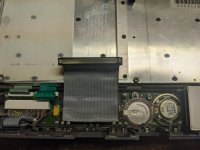That's some really dedicated work, impressive commitment. I wonder if it is feasible to make a new flat flex cable using e.g. an Oshpark flex PCB service? Probably not cheap, and likely would take just as long to do all the measurements.
Any luck with the trackball bezel? I'm looking for some rollers for my 145, but I also don't want to buy the entire trackball assembly. Now I'm considering taking some measurements and following your lead to make my own

I hadn't thought about having one fab'd, but why not? I've used Oshpark a few dozen times for various FR4 prototypes, but didn't know they did flex. That's awesome! Now I'm wishing I hadn't been so quick to slice-and-dice my original cable. I'll save all the bits just in case...
I did get a lead on a bezel and port cover from a gracious member, so by midweek once those and the 3A power adapter I also ordered arrive, this thing should be 100% (minus the battery of course, but that'll be another thread...)
Finally, I did manage to get issue #2 outlined above resolved. After dismantling / reassembling the chassis several times and poking and prodding around to recreate the behavior, I zeroed in on the 72-pin interconnect cable (yes, the one I'd just rebuilt). I determined that it isn't a problem with the cable, however, but rather the connector. The interconnect cable connector has a very small cavity it sits within in front of the interconnect board and above the daughter board. Any side to side or fore/aft load on the cable when compressing the halves of the case together will cause connection issues. I carefully routed and creased the cable in such a way that the connector slides right into its narrow pocket during reassembly and all is well.
This is probably what was wrong with my KB in the first place, now that I understand the issue better. Ah well, no harm done in replacing the ribbon. This is another design weakness frankly and is, I suspect, the reason others have reported similar issues and end up replacing the interconnect board as a solution. Given the pin density, limited physical space, and minimal insertion force, this connector really should have lock clips or something to retain it securely. Something I may seek to add if it continues giving me grief. For now though, I guess it's time to update my sig to include a functional PB-180c...


